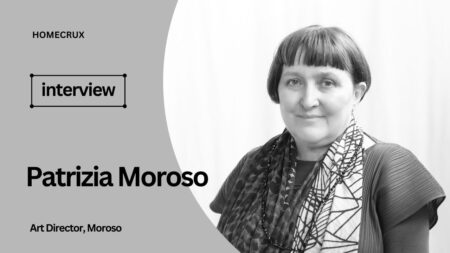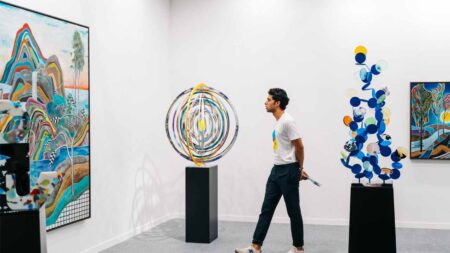Shundra Harris is a Texan who began as a Computer Engineer, only to realize interior designing was her true calling. Founder of Shundra Harris Interiors, she has taken on numerous residential and commercial projects, reveling in her life-long dream. The current Director-at-large of the prestigious American Society of Interior Designers (ASID), Shundra with her team has been creating integrated design solutions for a variety of projects ranging from residential to commercial and from hospitals to educational institutes.
In this exclusive interview with Homecrux, Shundra Harris talks about sustainability in her design; Pantone Color of the Year 2024 (Peach Fuzz); her belief in ‘healing through color;’ and racial biases in the interior design industry. Read on for an eclectic conversation.

Homecrux (HC): What do you think is the power of design in people’s lives? How does it transform one’s life and home?
Shundra Harris (SH): In a broader sense, design has an enormous impact in and on our lives, shaping our experiences, emotions, and how we perceive our environments, and even the world at large. The power of design helps us to elevate our behaviors, modulate our moods, and find solace and deep satisfaction. Our homes are no longer just places of dwelling, but through design have become where we live well, sometimes work, play, learn, rest, and heal.
We so often focus on our first impression of a design which is aesthetic. But effective design should offer us an enhanced quality of life in our homes that includes functionality and organization, comfort, efficiency, accessibility, tranquility, balance, and so many other benefits that are personalized just for us.
Our goal, as design professionals, is to educate the world about the intricate design principles and evidenced-based, inclusive, and sustainable design strategies that lie beneath the aesthetics that take our breath away. These methods prioritize the needs of people and nurture our well-being.

HC: Tell us about your childhood. How and when did you begin as an interior designer and how has your journey been?
SH: I was raised in a single-parent household with an exceptionally creative mother. She possessed a level of design expertise that would easily classify her as a professional today. Little did I know that our impromptu furniture rearrangements and amateur space planning sessions would serve as my initial exposure to the world of design. However, while I possessed the creative gene, I was unaware that Interior Design was an option for me (a realization that still exists today for many minority children…that I work to change). So, I became a Computer Engineer.
Interior design sort of found its way into my life. While working as an Engineer, I decided to remodel my own home. Quickly realized that although I had some raw talent, I lacked the necessary expertise. So, I enrolled in a few continued education classes at a local university and some local DIY workshops. Those construction-focused classes proved incredibly enlightening but were still not enough. After completing the remodel, my friends and family noticed my creativity and began seeking my help with their interior projects, essentially forming my initial client base.
I embraced their projects, laying tile floors and demolishing walls, all while moonlighting from my day job. During my research, I stumbled upon interior design schools and knew I wanted to take a deeper dive into this field. It was essential for me to find an accredited program, as I was committed to pursuing NCIDQ certification. The rest, as they say, is history.

HC: Gender and racial biases are still prevalent across the world in all industries. What sort of challenges did you have to go through when you began? How has the industry changed over the years?
SH: Even though the world has become increasingly aware in recent years, this issue continues to be a significant concern. I still encounter stereotypes and biases related to my skills and professionalism in the interior design industry regularly. The lack of diversity in the field has often made me feel isolated, but I am actively working to address this by mentoring aspiring designers of color whenever possible. Unfortunately, discrimination and microaggressions remain persistent challenges within the industry as well.
Overcoming these challenges often requires a combination of personal resilience, advocacy for change within the industry, education and awareness efforts, and the support of diversity and inclusion champions. Many individuals and organizations are actively working to address these biases and create more equitable opportunities within the field of interior design. However, we still have a long way to go.
HC: How do you stay abreast with the ever-evolving trends? What trends do you think will rule in 2024?
SH: In this industry, we are fortunate to have organizations and publications that promote the business, influence, and impact of interior design. For instance, the American Society of Interior Designers recently released its 2024 Trends Outlook Report. I enjoy reading Business of Home magazine, which offers insightful articles covering aspects of the design industry. Additionally, I try to stay informed about global events to understand potential impacts on my industry.

I firmly believe that Health and Wellness will maintain their prominence in 2024 and beyond as we continue to explore the essence and real meaning of design and work towards producing and implementing more sustainable products and practices. The ASID 2024 Trends Report found this, too, noting: “Consumers continue to seek products that improve health, sleep, and mindfulness…seeking more ‘natural’ and ‘clean’ products,” and that they will “spend more on products that improve health, fitness, nutrition, appearance, sleep, and mindfulness.”
Additionally, with the evolving changes in our households and how we live, our industry is poised to provide design solutions that accommodate multi-generational and intergenerational living. In doing so, we will be required to continue to understand the unique requirements and characteristics of different generations and how they can interact successfully. Akin to our family living, closeness, and connection are ideas that are also a mainstay, especially after the long separations and effects of Covid. Certainly, diversity, equity, inclusion, and equality must continue to be a perpetual and foundational focus that underscores all key aspects of the design industry’s operations and strategies.
HC: What are the must-have aspects of all your projects? How do you include sustainability in design?
SH: The essential elements of my projects include establishing a collaborative relationship with my clients and ensuring effective communication with all project professionals. This is where it all starts for me. These practices help result in smooth project execution, prevent delays, and ultimately lead to design solutions that uplift and enrich our clients’ experiences.

My initial approach to incorporating sustainability is educating and raising awareness of the possibilities. It’s common for clients and even fellow design and construction professionals to lack knowledge about sustainable practices and products. Additionally, I prioritize the specification of sustainable materials whenever feasible, and I make certain to include features that enhance indoor air quality, water efficiency, and other sustainable attributes in my designs.
HC: How does color define a space? How does Pantone color of the year affect your design work? What do you think of Peach Fuzz “the color of the year” for 2024? How is it going to pan out; or do you think other colors will form the greater part of your ideas?
SH: That’s a timely question. In my Seminars by Design company, I developed and taught a class called “Healing + Color.” Color is the foreground for any space. When used intentionally, considering the meaning and symbolic nature of color, it is a valuable tool used in design to relax, change the mood, and alter people’s perceptions of things and spaces. Color is vital to the healing process of patients, in hospitals, homes, and every space we encounter.
The Pantone color of the year is the trendsetter across industries that potentially influences consumers and ultimately design. It provides creative inspiration for our industry and permits us to design outside of our proverbial boxes. This knowledge is also a way to showcase to our clients that we are informed and keeping up with the latest trends.
I love the subtle energy, warmth, and coziness of Peach Fuzz. For me, there is a delightful allure that pulls your gaze into the color and imparts a feeling of serenity and security.

Well, my favorite color is orange, so Peach Fuzz is undoubtedly a suitable choice for my personal style and design preferences for the year. I’ve looked at this color within various palettes, and it plays well in harmonizing in different contexts.
HC: What role do technology and design software play?
SH: In my opinion, technology and design software are both necessary tools for all stages of design development, including managing the business of design. On any given project, design professionals are managing hundreds to thousands of details and decisions. Technology and design software helps our clients visualize our intentions, develop space plans, select materials, research, collaborate with others, be more efficient, manage our projects, improve accuracy, expand our creativity and communication and so much more. Even AI, when used responsibly and ethically, has transformed the productivity and efficiency of our industry. Embracing these tools is crucial for staying competitive.
HC: How has The American Society of Interior Designers (ASID) been instrumental for young designers? What is your role here as the Director-at-large?
SH: ASID is committed to the development of students and emerging professionals and the membership overall. I’ve had the pleasure of mentoring students one-on-one and speaking to groups of students about the industry. They are sharp and want to understand real-world and practical design information.
ASID provides students and emerging professionals with networking opportunities with experienced professionals, resources and workshops, career development, recognition in student competitions, scholarships and awards, industry exposure, mentorship programs, leadership opportunities, and community and support, to name a few. I began my ASID journey as a student and have witnessed the expansion of programming geared toward the success of students and emerging professionals, which ultimately enhances our industry.
My role as a Board of Director is to – along with other Board members – oversee, guide, and advise the organization’s strategic direction and policies. Our goal is to provide leadership and governance to ensure that ASID effectively serves its members (including students and emerging professionals) and advances the interior design profession. We all love the Society and work tirelessly together to promote and further the profession.

HC: Do you have any pearls of wisdom for our readers to make their homes better by embracing ageless trends without breaking the bank?
SH: This is one of my favorite questions. I believe that everyone deserves good design and many financially manageable timeless trends can be employed.
- Stick With the Classics. Neutral color palettes with pops of interchangeable color, clean lines, and simple shapes never go out of style
- Mix Old and New. A blended space is more interesting and adds character
- Declutter. Keep your space open and inviting
- Nature Rules. Bring the outdoors in with wood, stone, and plants
- Lighting Matters. Shedding light on your signature pieces brings them alive and make sure there’s adequate lighting in your space
- Quality First. Having fewer quality pieces will give an elevated appeal
- No Blank Walls. Art has purpose and meaning. Include it in your space

We thank Shundra Harris for taking out time to have this insightful exchange with us!
Follow Homecrux on Google News!




